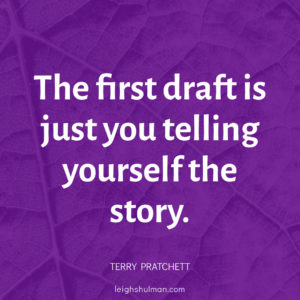So you’ve written the first draft of a book. Congrats. Now what?
First drafts are rarely complete novels, and it takes a shift in thinking to transform your draft into a finishing book. The first draft is about getting the story down, learning the details, and figuring out what you want from your book. Terry Pratchet says “the first draft is just you telling yourself the story.”
Then once you know what you want to say, it’s time to cut, prune, shape, and various other gardening metaphors so you can take your draft to the next level.
While every book is different and therefore every writer will follow a different path to editing, there are some basic rules you can follow. These are the steps I use when writing my books and the ones through which I guide writers when I work with them one-on-one and at writing retreats.
In light of that, I’ve put together seven steps you can use to edit your novel to completion.

1. Give your first draft some space
Once you write THE END on that final page, it’s time to take a break. Do something else for a while.
Take two weeks to a month to give yourself time to forget what you wrote. It will help you approach your work with a fresh mind. When you return to your book, you’ll notice things you couldn’t see before.
It’s helpful to time your break around natural deadlines and holidays. When I wrote a book during National Novel Writing Month one year, I took all of December as a break. I spent the holidays with my family, relaxed, and was ready to begin again in the new year.
One caveat: Don’t let space turn into procrastination. It’s easy to trick yourself into believing you’re still taking a break as more and more time passes.
2. Print and read like it’s not shitty and not a draft
Print out your entire book, take it to a cafe or somewhere you enjoy reading, and read through the whole thing. That’s how you’d read any other book. Your book deserves the same attention.
When you print and read, you can’t make changes. It forces you to see your writing as a reader would.
Write comments in the margins. What do you love? What’s not working for you?. Let your natural reactions guide you. You know when you don’t believe the character you’re reading on the page. You know when a plot point is forced. Just take a note it and keep reading.
3. What’s it all about?
When you’ve completed a full read-through, write out the About of your book in one sentence.
What do I mean by an About? I want you to write down what you want your readers to understand and feel when they’re done reading your book. You can read more about how to do that here.
What’s the benefit of distilling your first draft down to one sentence?
Every book, short story, movie, or play has a main point. There may be underlying messages. There may be additional subtleties, but the main point and plot guide your readers to a deeper understanding of the world
It can be an adventure, a lesson, a truth of life.
Your About sentence will help you make choices about the characters, the structure, and the plot as you continue writing.
For example, I’m currently working with a client whose book is About the ways sisterhood supports us during the hardest times of our lives. When the main character’s family dies in an earthquake, she must decide whether or not she’ll travel across a continent to find the person who caused the earthquake. Each woman who helps her along the way ties directly into the About. When a female character harms her, that also shapes the way we see sisterhood.
Some About sentences of books and movies:
Love in the Time of Cholera by Gabriel Garcia Marquez: We learn a new definition of love as timeless and without defined boundaries as we watch two people go through their lives in love but never together until the very end.
Six Feet Under: Life is a series of events, big and small that moves relentlessly toward the inevitable final end.
The Eternal Sunshine of the Spotless Mind: Erasing our memories, even bad ones, erases who we are and who we can become.
Once you know where you’re headed, it’s time to dive into the nitty-gritty details of shaping your characters, and plot..
4. Define your characters, particularly the narrator.
Who are the main characters of your book?
What role do they play in moving your plot forward? What are the salient characteristics of each character? Is each character properly portrayed? Do you need more information? Less? Perhaps you want a bit of mystery to be revealed later in the book. Are they believable?
Many people forget to include the narrator as a character in the novel, especially when the narrator is omniscient and not actually part of the action of the book.
The narrator will in many ways guide the structure of your book.
For example, Death is the narrator in The Book Thief. Death is a constant presence but more of an omniscient onlooker. Death does not take an active part in the action of the story. Death is trustworthy. We can believe what he says about the characters and his viewpoint adds another dimension to the novel.
Compare that to Henry Hill in the movie Goodfellas. Henry tells the story, but we only learn at the very end of the movie that he’s actually telling his story from the witness stand as he testifies against his old mafia friends. Suddenly, you realize that in the retelling, Henry hasn’t once killed anyone or broken any laws that might jeopardize his immunity.
Do you believe him? How does that change the way you see the story?
Get to know your characters as deeply as possible. Who are they? What do they want? Who do they love? What do they eat for breakfast? The better you know them, the more naturally their personalities will translate to your story as you write.
Dive more deeply into your characters with the following:
- How to write compelling diverse characters
- How to connect your characters to the main point of your story
- 6 Ridiculous Writing prompts to develop strong male characters
- Develop your character’s identity via these Black female protagonists
5. Find the shape of your first draft.
The structure of your book is like the bones of your body. Without it, your book has no shape. With it, you have direction and method to tell your story, introduce your characters and foreshadow future events.
Is one narrator telling the story chronologically? Do you have more than one narrator? Do you intersperse history along with character narrative? Is your story all happening in the present or do you sometimes go back and tell what happened before?
There are many techniques you can use to develop it.
- A For Dummies Checklist of things to consider when creating your structure
- How Story Structure Creates Foreshadowing from The Creative Penn
- Seven Ways To Outline Your Book (And what to do when you get stuck)
- The Snowflake Method to Create Structure in Your Novel by Randy Ingermanson at Advanced Fiction Writing
- The Two Pillars of Novel Structure from Writer’s Digest
- Create Structure Using Index Cards from Writer’s Digest
Puzzle Piece Your First Draft Into Order
First, cut the novel into individual pieces. Separate out your scenes, pieces of descriptive narrative, and dialogues. If you took notes on the printout of your book, make sure not to chop the notes you’ve taken into unreadable pieces when you cut. Something I, unfortunately, learned the hard way.
Then, puzzle piece the sections together in the order that makes sense. This allows you to experiment and mix and match parts of your novel to test different ways of setting the structure.
You can lay it out on the floor. Attach the pieces to a clothesline with clothes pins. Or just stack the pieces together on your desk. Whatever works best for you.
The puzzle piece method is incredibly powerful but can also be tedious if you separate the novel into too many pieces. It’s best to break it down into scenes, longer dialogues, and sections that fit together naturally.
Then you reassemble your novel according to the new structure you’ve created by cutting and pasting the pieces into your digital file.
6. Be like a butcher
This is the best advice ever given to me about writing second drafts. It is also the hardest because most writers don’t like to let go of our darlings. I know it’s easy to fall in love with a passage or a sentence or a scene, but if it’s not working for the piece as a whole, it has no place there. CUT!
Think of yourself as a sculptor, but instead of carving clay or stone, you’re removing the extra words from your first draft and taking a messy pile of story into something your readers can see clearly and admire.
A good way to dispose of your extra pieces? Create a separate document where you paste all the bits you’ve removed. You can always reincorporate them if you change your mind. Or maybe you’ll use them in a short story or some other piece.
While I rarely go back and use what I cut, saving the pieces gives me peace of mind because I can go back if I want.


